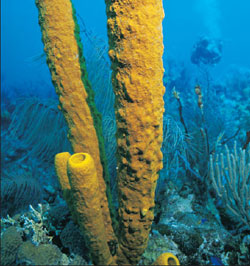Mesozoa and Parazoa
 |
| A Caribbean demosponge, Aplysina fistularis. |
Sponges are the simplest of multicellular animals. Because cells are the elementary units of life, evolution of organisms larger than unicellular organisms arose as an aggregate of such building units. Nature experimented with producing larger organisms without cellular differentiation—certain large, single-celled marine algae, for example—but such examples are rarities. Typically nature has held stubbornly to multicellular construction in the progress toward higher organization. There are many advantages to multicellularity as opposed to simply increasing the mass of a single cell. Since it is at cell surfaces that exchange takes place, dividing a mass into smaller units greatly increases the surface area available for metabolic activities. It is impossible to maintain a workable surface-to-mass ratio by simply increasing the size of a single-celled organism. Thus multicellularity is a highly adaptive path toward increasing body size.
Strangely, while sponges are multicellular, their organization is quite distinct from other metazoans. A sponge body is an assemblage of cells embedded in a gelatinous matrix and supported by a skeleton of minute needlelike spicules and protein. Because sponges neither look nor behave like other animals, it is understandable that they were not completely accepted as animals by zoologists until well into the nineteenth century. Nonetheless, molecular evidence suggests that sponges share a common ancestor with other metazoa.
Position in Animal Kingdom
Multicellular organisms (metazoa) are typically divided into three grades: (1) Mesozoa (a single phylum), (2) Parazoa (phylum Porifera, sponges; and phylum Placozoa), and (3) Eumetazoa (all other phyla).
Although Mesozoa and Parazoa are multicellular, their plan of organization is distinct from that in eumetazoan phyla. Such cellular layers as they possess are not homologous to the germ layers of Eumetazoa, and neither group has developmental patterns in line with other metazoa. The name Parazoa means the “beside-animals.”
Biological Contributions
- Although the simplest in organization of all metazoa, these groups do compose a higher level of morphological and physiological integration than that found in protozoan colonies. Mesozoa and Parazoa may be said to belong to a cellular level of organization.
- Mesozoans, although composed simply of an outer layer of somatic cells and an inner layer of reproductive cells, nevertheless have a very complex reproductive cycle somewhat suggestive of that of trematodes (flukes). Mesozoans are entirely parasitic.
- Placozoans are essentially composed of two epithelia with fluid and some fibrous cells between them.
- Sponges (poriferans) are more complex, with several types of cells differentiated for various functions, some of which are organized into incipient tissues of a low level of integration.
- Developmental patterns of these three phyla are different from those of other phyla, and their embryonic layers are not homologous to the germ layers of Eumetazoa.
- Sponges have developed a unique system of water currents on which they depend for food and oxygen.




